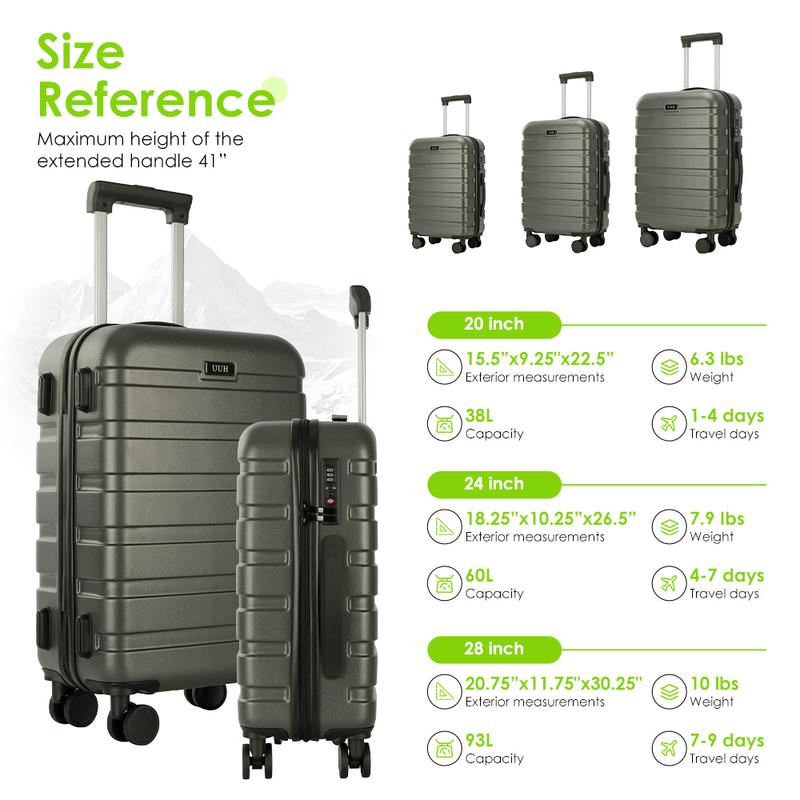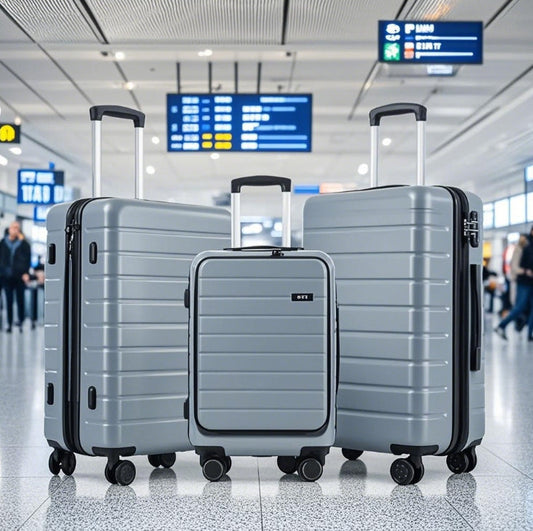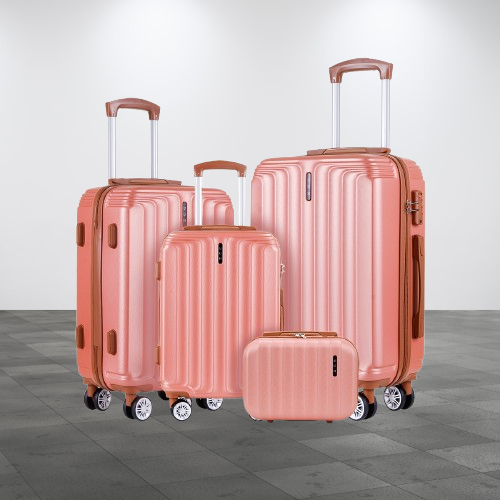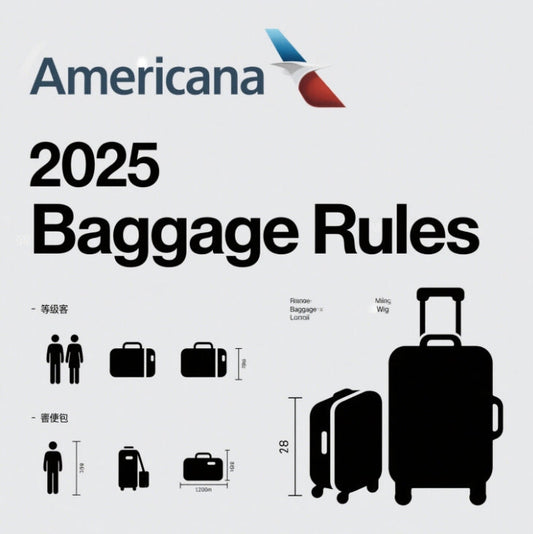Carry On Size: Essential Tips for Hassle-Free Travel
Eric Wong
Traveling light by relying solely on a carry-on bag can completely reshape your travel dynamics, whether you’re a seasoned globetrotter or an occasional vacationer. It doesn’t just ease the journey; it liberates you from excess baggage fees and extended waits by the luggage carousel. In this guide, we’ll delve into the nuances of carry-on dimensions, optimal packing methods, and the process of selecting a carry-on that harmonizes with your travel plans.
The Significance of Carry-On Dimensions in Today’s Travel Scene
Streamlined Travel with a Carry-On
Using just a carry-on bag grants freedom from baggage claim lines and ensures your essentials remain with you throughout the journey, providing flexibility—ideal for tight schedules. A well-packed carry-on minimizes the chances of misplaced or delayed checked luggage, allowing you to travel with confidence.
Bypassing Extra Fees for Oversized Bags
Oversized bags can lead to unexpected fees or force you to check them at the gate. Knowing the size limits of your airline in advance can help avoid unexpected costs and last-minute inconveniences.
Carry-On Size Standards by Region and Airline
U.S. Airline Standards for Domestic Flights
Most U.S. airlines follow a general guideline allowing carry-ons up to 22 x 14 x 9 inches, including wheels and handles. However, some budget airlines may have more restrictive policies, so always check your specific carrier’s guidelines.
U.S. Airline Carry-On Size Comparison Chart
Here’s a comprehensive table that breaks down the specific carry-on size restrictions for major U.S. airlines. Each airline's standard allowance for carry-ons is listed in inches and includes height, width, and depth measurements as well as any unique rules to be aware of.
| Airline | Carry-On Size Limit | Weight Limit | Personal Item | Notes |
|---|---|---|---|---|
| American Airlines | 22 x 14 x 9 inches | None specified | Yes, under seat, approx. 18 x 14 x 8 inches | No charge for standard carry-ons. Premium routes may vary. |
| Delta Airlines | 22 x 14 x 9 inches | None specified | Yes, must fit under seat | Weight restrictions on international routes; check ahead. |
| United Airlines | 22 x 14 x 9 inches | None specified | Yes, under seat, approx. 17 x 10 x 9 inches | Basic Economy fares do not allow a carry-on, only a personal item. |
| Southwest Airlines | 24 x 16 x 10 inches | None specified | Yes, under seat, approx. 18.5 x 8.5 x 13.5 in | Larger carry-on size allowance; no fee for carry-ons. |
| JetBlue Airways | 22 x 14 x 9 inches | None specified | Yes, under seat, approx. 17 x 13 x 8 inches | Blue Basic fares allow only a personal item; pay for carry-on option. |
| Alaska Airlines | 22 x 14 x 9 inches | None specified | Yes, must fit under seat | Consistent carry-on policy; regional partners may vary slightly. |
| Spirit Airlines | 18 x 14 x 8 inches (personal item) | None specified | Yes, under seat, approx. 18 x 14 x 8 inches | Fee for all carry-ons except for personal items. |
| Frontier Airlines | 18 x 14 x 8 inches (personal item) | None specified | Yes, under seat, approx. 18 x 14 x 8 inches | Charges for all carry-ons; only personal item included with fare. |
| Hawaiian Airlines | 22 x 14 x 9 inches | 25 lbs (select international routes) | Yes, under seat | Check restrictions for inter-island flights; policies may vary. |
| Allegiant Air | 16 x 15 x 7 inches (personal item) | None specified | Yes, under seat, approx. 16 x 15 x 7 inches | Fee for carry-ons; only personal item included in fare. |
International Airline Variations
For international travel, carry-on size restrictions can differ widely. European carriers, for example, sometimes allow bags up to only 21.5 x 15.5 x 9 inches. Make sure to check for size variations based on the destination to avoid issues at the airport.
Why It’s Essential to Check Airline Policies
Even among major carriers, size policies can vary. For instance, some airlines restrict weight limits while others don’t. To avoid surprises, always verify carry-on size and weight restrictions directly from the airline’s website.
Choosing the Perfect Carry-On Bag for Your Needs
Benefits of Hard vs. Soft Shell Luggage
UUH Hard-shell carry-ons provide greater protection for fragile items but may offer less flexibility for packing. Soft-shell bags, on the other hand, can be easier to fit into overhead compartments and typically offer expandable compartments for added space.
Features to Look for in a Quality Carry-On
Look for sturdy wheels, preferably 360-degree spinner wheels, a solid telescoping handle, and durable materials. Internal organization, such as zippered compartments and compression straps, also helps keep your items secure and accessible.
Read more: Hard vs. Soft Luggage – Which Suits You Best?
Space-Saving Designs and Organization
Choosing a carry-on with built-in organizational pockets and packing sections can make a big difference. It keeps items like passports, chargers, and snacks easily accessible while maximizing overall space.
Packing Strategies for Carry-On Travel
Efficient Packing with Multipurpose Clothing
Choose clothing that can be mixed and matched easily, like neutral-colored shirts and versatile pants or skirts. Multi-purpose items like scarves and cardigans add style and warmth without occupying much space.
How Packing Cubes Save Space and Time
Packing cubes are an excellent investment for organized packing. They compress items, making it easier to fit more into limited space while keeping your clothes wrinkle-free and easy to access.
Organizing Toiletries and Staying Within TSA Limits
When packing liquids, adhere to the TSA’s 3-1-1 rule: all liquid containers should be no more than 3.4 ounces and fit into a single quart-sized bag. Consider solid alternatives, like shampoo bars and lotion sticks, to save even more space.
TSA Security Rules and Tips for Smooth Screening
The 3-1-1 Liquids Rule
This rule requires that all carry-on liquids be in containers no larger than 3.4 ounces, all fitting into one quart-sized bag. Following these rules will help you breeze through security without issues.
Tips for Handling Electronics and Cables
Laptops and other electronics often need to be taken out during security screening. Keep electronics in an easily accessible pocket or compartment to make the process smoother. Tidy up cables using cord organizers to avoid tangling.
Common Carry-On Mistakes to Avoid
Overpacking and Not Leaving Room for New Items
Many travelers overfill their bags, which leaves no space for souvenirs or additional items picked up on the trip. To prevent this, pack only what you need, and plan a little extra room for new finds.
Ignoring Weight Limits
Even if your bag fits within the size limits, some airlines have weight restrictions for carry-ons. Redistribute items if necessary and consider carrying heavier items, like a laptop or camera, in your personal item to stay within the weight limit.
Advantages of Traveling Carry-On Only
Reducing Travel Costs with Carry-On Only
Going carry-on only saves on checked bag fees, which are increasingly common across airlines. For budget-conscious travelers, this is a quick way to cut down on travel costs.
Faster Airport Transitions and Stress Reduction
With only a carry-on, you can skip the baggage claim wait and head straight to your destination upon landing. The lighter load also minimizes stress, helping you stay focused and relaxed throughout your journey.
Why Knowing Carry-On Size Restrictions Matters?
Each airline’s carry-on requirements vary based on aircraft, ticket class, and even route. Having a bag that fits within these limits helps you avoid last-minute fees and minimizes the chance of needing to check your bag. Plus, with more travelers opting for carry-on-only travel, understanding the guidelines gives you an edge in smooth, efficient packing.
Exceptions and Additional Tips
1. Gate-Checked Bags
When flights are at full capacity, even approved carry-ons may need to be gate-checked if overhead space fills up. This often occurs on smaller planes and for flights with high occupancy. Always pack essentials (e.g., medications, travel documents) in your personal item in case your bag is gate-checked.
2. Regional and Partner Flights
Many major airlines operate with regional partners, such as American Eagle for American Airlines or Delta Connection for Delta. These smaller aircraft may have even stricter carry-on size limitations, so double-check if any leg of your trip includes a regional carrier.
3. Weight Restrictions for International Routes
While U.S. domestic airlines typically don’t impose carry-on weight limits, international routes may. Always check both the size and weight regulations when flying abroad. This is particularly relevant on airlines like Hawaiian Airlines for routes to Asia or Oceania.
4. Basic Economy Fare Restrictions
Some airlines, like United and JetBlue, restrict Basic Economy passengers to a personal item only. A carry-on bag can require an additional fee or an upgrade to a standard fare. Be sure to check if this applies, especially if you booked a budget ticket.
Conclusion
Traveling with a carry-on alone epitomizes efficient travel but requires familiarity with airline regulations to avoid fees and delays. By mastering the guidelines and packing intelligently, you’ll ensure a smooth, cost-effective, and stress-free journey. Always verify your airline’s policies, especially when booking Basic Economy or traveling internationally.
FAQs
1. Can I bring food in my carry-on bag?
Yes, you can bring food items in your carry-on. However, liquids or gels over 3.4 ounces are restricted, so any soups, sauces, or yogurts should meet the 3-1-1 rule.
2. What happens if my carry-on is too big?
If your carry-on bag exceeds airline limits, you may have to check it at an extra cost. To avoid this, confirm your bag’s dimensions and weight before your flight.
3. Can I have a personal item in addition to my carry-on?
Most airlines allow one personal item in addition to your carry-on, like a purse, backpack, or laptop bag. Check your airline’s policy for size limits on personal items.
4. Do international flights have different carry-on restrictions?
Yes, international airlines often have stricter size and weight restrictions, so it’s best to double-check the requirements for your destination before packing.
5. Are there any items I should avoid packing in my carry-on?
Avoid packing sharp objects, large liquids, and other prohibited items like flammable materials. These can result in your bag being flagged at security, leading to delays.



